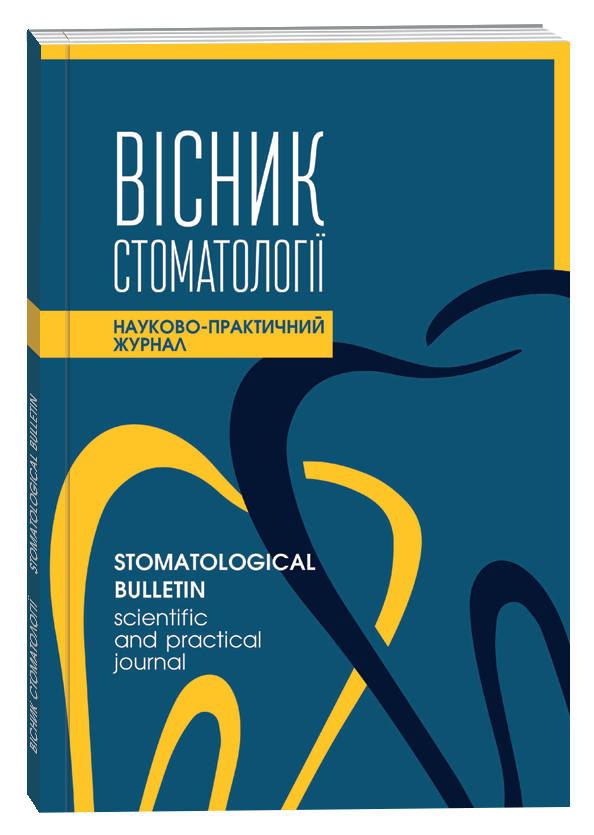THE NEW APPROACH TO TREAT PEDIATRIC MANDIBULAR BODY FRACTURES
DOI:
https://doi.org/10.35220/2078-8916-2020-35-1-75-79Keywords:
Pediatric mandibular body fractures, con-servative treatment, surgical treatmentAbstract
In this study a total number of 15 patients with a mandib-ular fracture are included. The age of the patients is less then 16 years old. This study was done in the period of 2010-2018.
A two groups were created based on the trauma location: Isolated mandibular traumas (mono and bilateral frac-tures)were 8 patients and 7 patients were diagnosed as comminuted mandibular fractures.
The methods of tretament was chosen to be either non surgical ( orthodontic + orthognatic screws and IMF) or cobmined with a surgical treatment. The laboratory tests and radiology was done to all patients. Radiology includ-ed OPG and 3D computer tomography. These patients were examined by pediatrician, pediatric surgeon, neurotraumatologist and anesthesiologist.
The treatment was planned individually based on the age and the fracture location. Three methods of treatment were used:Non surgical, surgical and combined. Out of 15 patients 3 patients were treated non surgically (or-tho,orthognatic screws and IMF ). The algorithm of non surgical treatment : it is important to do the reposition with orthodontic device immediately after trauma for two weeks I class of rubber rings and next step will be placing III class , III klass rubber rings and cross midline should be repositioned with rings as well. In case if only 10 or less teeth are present orthognatic screws should be placed to stabilize. As a result of conservative treatment, the mean deviation was 6.6mm before treatment, 0.3mm after 3 months of treatment, and no deviation was ob-served 6 months later. Only one surgical treatment was performed in 10 patients. Treatment consisted of osteosynthesis surgery with a titanium mini plate. The median deviation in these infants was 4.4 mm before treatment, 0.9 mm at 3 months after treatment, and 0.8 mm after 6 months.
2 out of 15 patients underwent combined surgical and or-thodontic treatment. This treatment includes osteosynthetic fixation of maxillaryandibular area with rubber rings. At the time of admission, the average devia-tion was 2 mm before treatment, 1.5 mm 3 months after treatment, and 0.5mm after 6 months. In each of the three treatment groups, the condition of the condyle – articlular eminence and the stages of treatment were controlled by the same doctor.
Conclusion. When comparing surgical and conservative methods in our study, it was decided that, depending on the clinical case, a conservative method can be regarded as a major method of choice. Currently, there are many ways to treat jaw fractures in children. Nevertheless, the number of complications is small. The superiority of one method over another method allows it to be applied in the standard way in every clinical setting. Proper and timely treatment can lead to severe consequences in the growing organism.
There is also no complex treatment protocol for age crite-ria, type of fracture, and localization of jaw fractures. Taking these criteria into consideration, the standard protocol is being developed.
References
Akbulut N., Tümer M., Ertem S. Çocuklarda kondil kırıklarında konservatif yaklaşım: bir olgu sunumu. Cumhuriyet Dent J., 2014, 17(3):291-295
Akdemir K. Çocuklarda alt çene kırıkları ve tedavi şekilleri. Bitirme tezi, 2007: 37 s.
Amro A., Samsonov V., Grebnev G., Iordanishvili A. Features of the clinical picture of mandibular fractures in dif-ferent age periods. VRMA, 2012; 4(40):49-51
Komelyagin D.Yu., Dergachenko A.V., Dubin S.A., Petukhov A.V. i dr. Lechenie detey s perelomami kostey chelyustno-litsevoy oblasti posle ukusov zhivotnykh.[ Treatment of children with bone fractures in the maxillofacial region after animal bites.] Sbornik tezisov VI Vserossiyskoy nauchno-prakticheskoy konferentsii s mezhdunarodnym uchastiem «Osteosintez litsevogo cherepa», 20-21 aprelya 2016 g., Moskva – M.: Izdatel'stvo Pervogo MGMU im. I.M. Sechenova; 2016:68.
Kharitonov D.Yu., Tikhonov E.V. Dependence of the severity of facial bone damage in children on the circum-stances of the injury. Vestnik. novykh meditsinskikh tekhnologiy. 2014; 1:1-3.
Agnihotri A., Agnihotri D., Dwivedi D., Dwivedi V. Management of pediatric mandibular fracture using acrylic cap splint & circum-mandibular wiring. A report of 12 cases. Int J Orthop Traumatol Surg Sci. 2015: 1(1): 16-19.
Allareddy V., Itty A., Maiorini E., Lee M. et al. Emergency department visits with facial fractures among chil-dren and adolescents: An analysis of profile and predictors of causes of injuries. J Oral Maxillofac Surg. 2014;72:1756-1765.
Chen H., Neumeier A., Davies B., Durairaj V. Analysis of pediatric facial dog bites. J. Craniomaxillofac trauma reconstruction, 2013; 6: 225-232.
Divesh S., Gauba K., Goyal A., Rattan V. Compre-hensive management of pediatric mandibular fracture caused by an unusual etiology. African Journal of Trauma, Jan-Jun. 2014; 3(1):39-42.
Filinte G., Akan I., Çardak G., Mutlu Ö. et al. Di-lemma in pediatric mandible fractures: resorbable or metallic plates? Ulus Travma Acil Cerrahi Derg; November. 2015;6(21):509-513.
Horswell B., Jaskolka M. Pediatric Maxillofacial Surgery. J Oral and Maxillofacial Surgery Clinics of North America. 2012;3(24):350-364.
Bragina V. G., Gorbatova L. N. Trauma of the max-illofacial region in children. Ekologiya cheloveka, 2014;2:20-24.









